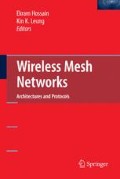Access this chapter
Tax calculation will be finalised at checkout
Purchases are for personal use only
Preview
Unable to display preview. Download preview PDF.
References
The SolarMESH Network. http://owl.mcmaster.ca/solarmesh/. McMaster University. Hamilton, Ontario, Canada., 2004.
L. Narvarte and E. Lorenzo, “On the usefulness of stand-alone PV sizing methods,” Progress in Photovoltaics: Research and Applications, Prog. Photovolt: Res. Appl., 8: 391–409, 2000.
H. A. M. Maghraby, M. H. Shwehdi, and G. K. Al-Bassam, “Probabilistic assessment of photovoltaic (PV) generation system,” IEEE Transactions on Power Systems, 17(1):205–208, 2002.
L. L. Bucciarelli, “The effect of day-to-day correlation in solar radiation on the probability of loss of power in a stand-alone photovoltaic energy system,” Solar Energy, 36(1):11–14, 1986.
L.L. Bucciarelli, “Estimating loss-of power probabilities of stand-alone photovoltaic solar energy systems,” Solar Energy, 32(2):205–209, 1984.
F.M. Safie, “Probabilistic modeling of solar power systems,” in Proc. of Annual Reliability and Maintainability Symposium, 1989., pages 425–430, 1989.
I. Abouzahr and R. Ramakumar, “Loss of power supply probability of stand-alone photovoltaic systems: A closed form solution approach,” IEEE Transactions on Energy Conversion, 6(1):1–11, 1991.
U. Grasselli, “Probabilistic design of high quality power supply photovoltaic systems,” in Industrial and Commercial Power Systems Technical Conference, 1993. Conference Record, Papers Presented at the 1993 Annual Meeting, 1993.
S. Saengthong and S. Premrudeepreechacham, “A simple method in sizing related to the reliability supply of stand-alone photovoltaic systems,” in Proc. of the Twenty-Eighth IEEE Photovoltaic Specialists Conference, 2000., pp. 1630–1633, 2000.
D. Macomber, “Optimizing residential photovoltaic system size using approximate reasoning,” in Proc. of First International Symposium on Uncertainty Modeling and Analysis, pp. 558–563, 1990.
M. Bouzguenda and S. Rahman, “Energy management onboard the space station-a rule-based approach,” IEEE Transactions on Aerospace and Electronic Systems, 27(2):302–310, 1991.
P. E. Baikie, M. I. Gillibrand, and K. Peters, “The effect of temperature and current density on the capacity of lead-acid battery plates,” Electrochimica Acta, 17:839–844, 1972.
Z. M. Salameh, M. A. Casacca, and W. A. Lynch, “A mathematical model for lead-acid batteries,” IEEE Transactions on Energy Conversion, 7(1):93–98, 1992.
A. Pesaran and V. Johnson, “Battery thermal models for hybrid vehicle simulations,” Journal of Power Sources, 110:377–382, 2002.
A. Farbod, “Design and resource allocation for solar-powered ESS mesh networks,” Master’s thesis, McMaster University, 1280 Main St. West, Hamilton, Ontario, Canada L8S 4K1, August 2005.
B. S. Borowy and Z.M. Salameh, “Optimum photovoltaic array size for a hybrid wind/PV system,” IEEE Transactions on Energy Conversion, 9(3):482–488, 1994.
A. D. Bagul, Z. M. Salameh, and B. Borowy, “Sizing of a stand-alone hybrid wind-photovoltaic system using a three-event probability density approximation,” Solar Energy, 56(4):323–335(13), April 1996.
W. Kellogg, M. Nehrir, G. Venkataramanan, and V. Gerez, “Generation unit sizing and cost analysis for stand-alone wind, photovoltaic, and hybrid wind/PV systems,” IEEE Transactions on Energy Conversion, 13(1):70–75, March 1998.
C. Leclerc and C. Masson, “Abnormally high power output of wind turbine in cold weather: A preliminary study,” International Journal of Rotating Machinery, 9(1):23–33, 2003. doi:10.1155/S1023621X03000034.
D.Heinemann, “Energy Meteorology: Lecture Notes,” Postgraduate Programme Renewable Eenergy Carl von Ossietzky University, 2002.
F. Zhang, T. D. Todd, D. Zhao, and V. Kezys, “Power saving access points for IEEE 802.11 wireless network infrastructure,” in Proc. of IEEE Wireless Communications and Networking Conference 2004 (WCNC’04), March 2004.
Y. Li, T.D. Todd, and D. Zhao, “Access point power saving in solar/battery powered IEEE 802.11 ESS mesh networks,” in Proc. of the Second International Conference on Quality of Service in Heterogeneous Wired/Wireless Networks (QSHINE’2005), August 2005.
IEEE Standards Department. Part 11: Wireless Medium Access Control (MAC) and Physical Layer (PHY) Specifications: Medium Access Control (MAC) Quality of Service (QoS) Enhancements. IEEE Press, 2005.
IEEE Standards Department. 802.11s ESS Mesh Networking working group, 2004.
National Solar RadiationData Base. http://rredc.nrel.gov/solar/. National Renewable Energy Laboratory (NREL), U.S. Department of Energy, 2004.
NationalClimate Data and Information Archive. http://www.climate.weatheroffice.ec.gc.ca/. The Meteorological Service of Canada, Canada, 2004.
Marlec EngineeringCo Ltd. “Rutland 503 Wind Charger Data Sheet”. http://www.marlec.co.uk/products/prods/rut503.htm.
Canadian Wind EnergyAssociation CanWEA. “Cost Comparison for Small Wind Turbine Sizes”. http://www.smallwindenergy.ca/en/Overview/Costs/CostComparison.html.
Author information
Authors and Affiliations
Editor information
Editors and Affiliations
Rights and permissions
Copyright information
© 2008 Springer Science+Business Media, LLC
About this chapter
Cite this chapter
Sayegh, A.A., Todd, T.D., Smadi, M.N. (2008). Resource Allocation and Cost in Hybrid Solar/Wind Powered WLAN Mesh Nodes. In: Hossain, E., Leung, K. (eds) Wireless Mesh Networks. Springer, Boston, MA. https://doi.org/10.1007/978-0-387-68839-8_7
Download citation
DOI: https://doi.org/10.1007/978-0-387-68839-8_7
Publisher Name: Springer, Boston, MA
Print ISBN: 978-0-387-68838-1
Online ISBN: 978-0-387-68839-8
eBook Packages: EngineeringEngineering (R0)

